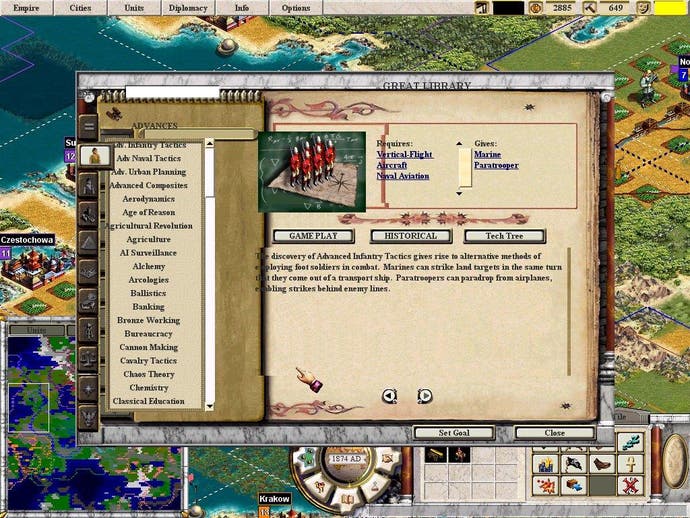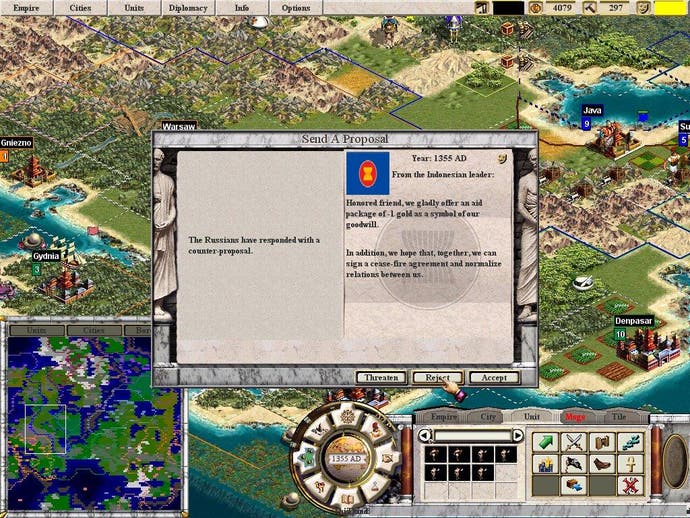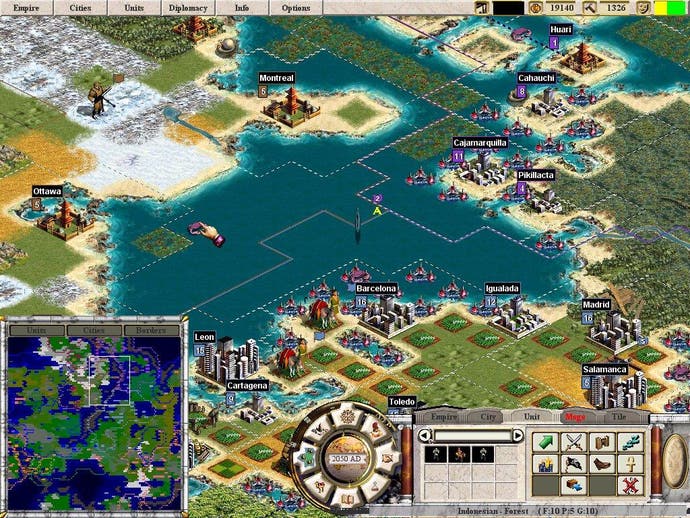Call To Power II
Preview - a hands-on look at the forthcoming sequel to turn-based strategy game "Civilization : Call To Power"
"Civilization" remains one of the most popular and addictive strategy games of all time, putting you in control of a small tribe of bronze age settlers and then allowing you to guide them to scientific enlightenment and global domination over a period of several thousand years.
The game has spawned an official sequel as well as numerous add-on packs, bundles and tie-ins. The franchise was rather chaotic until recently though, with Sid Meier (the man with his name on the front of the Civilization box in big gold letters) producing a rather disappointing follow-up to the game called "Alpha Centauri", while Activision and Microprose fought over the rights to the Civilization name.
In the end the companies came to an understanding, with El Sid and company now working on an official "Civilization III" for Microprose, while Activision were allowed to release their own take on the game, "Civilization : Call To Power". Given the turbulent history of Civilization, it's perhaps not surprising that one of the innovations in Call To Power was the ability to bring your enemies to their knees with armies of lawyers...

Inheritance
And so we come to "Call To Power II", which has dropped the Civilization name but holds on to the classic gameplay of the original. If you were expecting huge sweeping changes from the sequel you're likely to be disappointed - it's all still slow paced and turn-based, rendered in glorious 2D sprite-o-vision. But given how much fun the original was, that's no bad thing.
What Activision have done with the sequel is to go through the game and add a whole host of little tweaks and tucks to the formula. For starters the game now includes more turns, even though the game is still restricted to the period from 4000BC to 2300AD. The bronze age no longers flashes past in a handful of turns, and the whole pace of the game has been balanced out somewhat. And almost everything else has been re-balanced, re-tuned or otherwise improved as well, from the AI and combat to city management options and resources. The overall effect is to make the game easier to use and more fun, while also adding even more depth to a game which was already deeper than the Marianas Trench.
On the ease-of-use front, the great library (which contains information on all of the game's many technologies, units, buildings, wonders and other features) has received an overhaul, making it even simpler to navigate. You can browse through the tech tree with ease, compare your current government type with the various alternatives to see if it's worth switching, and single out particular items that you want to build and have the game highlight the technologies you need to research first.
Adding to the already massive replay value of the game are a wide range of "feats of wonder". Like traditional wonders, these give you all manner of bonuses when they are achieved, but their effects are only temporary, and instead of setting out to build them you will likely stumble across them by accident, as they are not documented in the manual or the in-game library. For example, the first race to circumnavigate the globe will get a movement bonus for all of their ships for several turns, and you can even emulate Al Gore by .. ahem .. creating the internet.

Smalltown England
As in previous Civilization games, you start the main single player campaign with settler units which can then be used to establish cities, and from there on in it's largely up to you how you develop your empire and ultimately set about winning the game, making the whole thing very open-ended.
The actual governing of your cities has been greatly improved and streamlined in Call To Power II though, taking in everything from easy construction of new units and buildings through to the way that cities now expand their influence over surrounding squares as their population grows, with cities spreading around each other to occupy the available space. Mayors can be put in charge of cities and tasked with improving their happiness level, building new wonders, or increasing military strength amongst other goals. This allows you to off-load the micro-management of individual cities on to the computer AI as your empire spreads, as keeping tracks on what was going on throughout dozens of cities could become very time-consuming towards the end of a game.
There is also a new improved build queue for cities, allowing you to give the computer an entire list of units and constructions to build, and then leave the city to look after itself. You can also create custom build queues and use them for other cities without having to select everything from scratch. Again, it reduces the amount of effort needed to manage a rapidly growing empire, making the game's later stages less daunting for new players and the chronically impatient.
A new city management menu also helps cut down on the clicking required to keep your empire on the rails, allowing you to flick through all of your cities and see an overview of their current condition. From there you can easily modify their build queues, "rush" construction of units and buildings by spending additional money to finish them more rapidly, view the happiness, pollution and crime levels of a city and all of the various factors which are effecting them, and select any units which are housed in the city.

Here Comes The War
There is also a new management screen for your army, allowing you to view military information, disband any obsolete units, adjust military readiness, and combine multiple units to form armies. These can now include anything up to a dozen individual units, which will all fight and move together as a single marker on the map.
Combat was always one of the big weaknesses in the Civilization series, and the rules have been almost completely rewritten for Call To Power II to make the game more realistic and less frustrating. This means that you should no longer see your shiny new tank platoon being destroyed by medieval archers, and a well balanced army can now overcome a numerically superior but poorly organised force. Just as in real life, combined arms tactics and getting a proper mix of defence, offence, and troops with ranged attacks is vital to producing an all-conquering army.
A new isometric battle view allows you to follow the action blow-by-blow to see whether your army is working effectively, and you can also now retreat if things are going badly for you, although your enemy will get one last parting attack before you can scarper. And with everything from archers, knights and triremes through to stealth fighters, tanks and vast underwater destroyers called kraken available as you develop, there is certainly a wide variety of military equipment on offer to use against your enemies.
And as with the first Call To Power, all-out combat is not the only way to grind down rivals. Non-conventional attacks using lawyers, missionaries and other parasitic scum can also drain enemy resources, encourage their people to rebel against them, and generally cause mayhem and mischief. This aspect of the game has been extensively re-balanced for the sequel, and should work much more convincingly for it.

Stop The Killing
Conquering the world is not the only path to victory, and a new diplomatic victory condition has been introduced, with the whole system of negotiating with other empires given a radical overhaul to make this more flexible and rewarding.
You can now combine a selection of offers and requests for money, resources and technology with proposals for truces, alliances and so on, and counter-proposals are now possible as well, so if you're not happy with what another country suggests you can offer your own compromise. If they refuse to accept your terms you also now have the option to threaten them with anything from piracy and economic embargo through to attacking one of their cities or launching a full scale invasion. How seriously they will take this sabre-rattling depends on the current strategic situation. For example, if you have one of their cities surrounded with troops they are more likely to react to a threat to demolish it, while if there is little contact between your empires a threat to break off trade with them will be less credible.
The diplomatic system rests on three basic parameters - trust, regard, and the personalities of the leaders involved. Attack another empire's settlers and your massacre of innocent civilians will sharply reduce their opinion of you, while launching a sneak attack or breaking an alliance will make them less likely to trust you again in future. Borders have a great impact on the game as well, and are now visible on all of the in-game maps so that you can tell at a glance where one nation ends and another begins. Straying into another country without their permission is at best likely to result in a sharply worded request to withdraw, and repeated incursions will eventually lead to war.
Veteran strategy gamers will also be glad to know that, as well as a full range of different AI personalities to take on, you will also be able to play over the internet or a LAN with up to eight players. Head-to-head modem play is also possible, but sadly the hot-seat and play-by-e-mail options have been stripped out this time round, although it is possible that they will be added back in with a patch at some point. The way that companies keep removing the useful play-by-mail options from their turn-based strategy games, you would think they had shares in British Telecom...

Conclusion
The original Call To Power was an excellent game in its own right, regardless of whether or not it could legally claim to be a true sequel to Civilization. The sequel looks set to take the winning formula and fix its few major flaws, while also adding some new elements, tweaking the gameplay, and generally improving its user-friendliness.
It looks like good news for hardcore strategy buffs and casual gamers alike then, but bad news for bosses and significant others everywhere. And if it proves to be as addictive as the original, the world's GNP is likely to dip sharply next year...
-
Call To Power II screenshots

